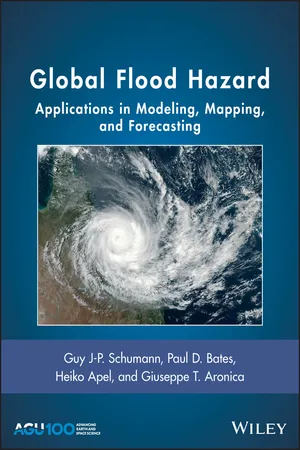
Global Flood Hazard
Applications in Modeling, Mapping, and Forecasting
- English
- ePUB (mobile friendly)
- Available on iOS & Android
Global Flood Hazard
Applications in Modeling, Mapping, and Forecasting
About This Book
Global Flood Hazard
Subject Category Winner, PROSE Awards 2019, Earth Science
Selected from more than 500 entries, demonstrating exceptional scholarship and making a significant contribution to the field of study.
Flooding is a costly natural disaster in terms of damage to land, property and infrastructure. This volume describes the latest tools and technologies for modeling, mapping, and predicting large-scale flood risk. It also presents readers with a range of remote sensing data sets successfully used for predicting and mapping floods at different scales. These resources can enable policymakers, public planners, and developers to plan for, and respond to, flooding with greater accuracy and effectiveness.
- Describes the latest large-scale modeling approaches, including hydrological models, 2-D flood inundation models, and global flood forecasting models
- Showcases new tools and technologies such as Aqueduct, a new web-based tool used for global assessment and projection of future flood risk under climate change scenarios
- Features case studies describing best-practice uses of modeling techniques, tools, and technologies
Global Flood Hazard is an indispensable resource for researchers, consultants, practitioners, and policy makers dealing with flood risk, flood disaster response, flood management, and flood mitigation.
Frequently asked questions
Information
1
The Need for Mapping, Modeling, and Predicting Flood Hazard and Risk at the Global Scale
ABSTRACT
The socioeconomic impacts of flooding are huge. Between 1980 and 2013, flood losses exceeded $1 trillion globally, and resulted in approximately 220,000 fatalities. To reduce these negative impacts of floods, effective flood risk management is required. Reducing risk globally is at the heart of two recent international agreements: the Sendai Framework for Disaster Risk Reduction and the Warsaw International Mechanism for Loss and Damage Associated with Climate Change Impacts. Prerequisites for effective risk reduction are accurate methods to assess hazard and risk, based on a thorough understanding of underlying processes. Due to the paucity of local scale hazard and risk data in many regions, several global flood hazard and flood risk models have been developed in recent years. More and more, these global models are being used in practice by an ever‐increasing range of users and practitioners. In this chapter, we provide an overview of recent advances in global flood hazard and risk modeling. We then discuss applications of the models in high‐level advocacy in disaster risk management activities, international development organizations, the reinsurance industry, and flood forecasting and early warning. The chapter concludes with several remarks on limitations in global flood risk models and the way forward for the future.
1.1. INTRODUCTION
1.2. BRIEF OVERVIEW OF RECENT ADVANCES IN GLOBAL FLOOD HAZARD AND RISK MODELING
Table of contents
- Cover
- Table of Contents
- Preface
- 1 The Need for Mapping, Modeling, and Predicting Flood Hazard and Risk at the Global Scale
- Part I: Flood Hazard Mapping and Modeling from Remote Sensing
- Part II: Flood Hazard Modeling and Forecasting
- Index
- End User License Agreement